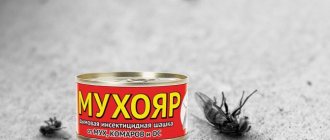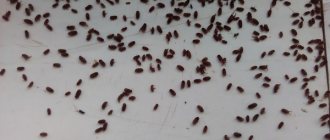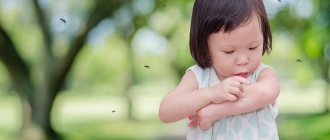At the beginning of summer, the gardens are filled with a peculiar buzz - large shiny bronze beetles are flying in. Representatives of the genus are largely similar to each other, but differ in color and size. The most common beetles are green, green with a golden or red tint. The marbled bronzefish differs in color; its elytra are dark with a characteristic light pattern. Insects can be found in the garden, where they drink the sap of trees or feed on nectar on flowers.
Description of the species
Marbled bronzeweed (Protaetia marmorata) belongs to the lamellar family. This is the largest representative of the genus of bronze beetles; the body length of the beetle is 19-27 mm. The color is black-bronze with a characteristic metallic sheen. The lower part of the body and limbs have a green tint. The body is elongated, narrowed at the back. The scutellum is triangular, convex, covered with notches and dotted spots. The middle is smooth, punctures are shifted to the sides.
The lower part of the chest and sides are covered with light hairs. The head is deeply punctured from above. It is significantly narrower than the pronotum and directed forward. Antennae with a plate-like club that opens into a fan shape. The hard, shiny elytra are covered with longitudinal rows of dots and a marbled pattern of white dashed stripes. There is a longitudinal stripe on the abdomen of the male. Forelegs with flat, digging tibiae. Legs are dark. The hairs on the lower legs are pinkish.
Information. A distinctive feature of bronzebacks is the holes on the sides of the elytra through which the wings protrude. At the same time, the elytra of the insects remain folded.
Bronze beetle: how to get rid of the pest?
It is important to know that there are no special methods for combating the bronze, as well as an exact plan for exterminating the population and subsequent prevention. The problem is that many still do not consider the insect a pest, so the effectiveness of all means used is relative
The most common method is the mechanical method, i.e. manual removal of the pest. It is recommended to start this procedure early in the morning in cloudy weather, since it is at this time that the beetle stops hiding and has minimal activity. But if there are a large number of insects, the method is only suitable for controlling its number within normal limits.
Anti-bronzing chemicals
Insecticides are recommended for severe damage
It is important to understand that spraying flowers during the day is unacceptable - this can cause the death of beneficial insects such as bees. Also, such products, if safety rules are not followed, can pose a threat to people, animals and plants themselves.
Although there are no specialized insecticides, the following are used to combat this beetle:
- Confidor;
- Aktar;
- Prestige;
- Bi-58;
- Diazinon;
- Medvetox;
- Fitoverm;
- Kinmiks;
- Iskra Bio;
- Sumi-Alpha;
- Fury.
When fighting bronze moth, soil treatment agents are more often used, as this guarantees safety for beneficial insects. Spraying plants should only be done early in the morning or evening. Regardless of the insecticide chosen, the procedure must be repeated after 2-3 weeks, since by this time new beetles will appear. In addition, it is recommended to carry out the fight together with neighbors, otherwise it will be impossible to completely get rid of the pest.
Folk methods of dealing with bronzing
Such methods are more gentle and have a deterrent effect. Mostly folk methods of struggle are represented by infusions and decoctions
It is important to know that such products can damage plants, so they must be used with caution.
The most effective methods are:
- Infusion of celandine. For 1 liter of hot water there are 100 g of dry celandine. The liquid should be infused for 1-1.5 days in a dark place. Before spraying, strain the solution.
- Wood ash. For 5 liters of water, only 15 g of ash is enough. The mixture must be infused for up to 2 days, after which add 25 g of grated laundry soap without fragrances.
- Liquid smoke based solution. For 10 liters of water you need 45 g of flavoring. To increase efficiency, you can add 50 g of dark laundry soap to the solution. There is no need to infuse the mixture.
- Infusion of horse sorrel. To 1 liter of hot water you need to add 30 g of crushed roots. Infuse the resulting liquid for only 2-3 hours. Afterwards you need to strain and spray the affected plants every 5 days.
In the evening, you can use light traps. In the most extreme cases, it is permissible to artificially breed the natural enemies of the golden bronze wasp - scolius wasps. But this method is difficult to implement.
Preventive measures
The main element of prevention is plowing the land. This is especially necessary in early spring and late autumn. This procedure will prevent the beetles from surviving the cold season.
The following basic rules of prevention should be adhered to:
Do not leave fallen leaves, humus or rotting wood
It is especially important to carry out cleaning with the onset of cold weather, because
It is in such organic remains that pupae most often hide. Attract natural enemies. Among domestic animals, chickens readily feed on the golden bronze. It was observed that adult chickens released into the flower garden independently hunt bronze fowl, helping to control their numbers. Monitor the condition of the plants. It is important to check flowers for damage. Most often, the golden bronzer feeds on white or light pink flowers, but in their absence it can also eat darker flowers.
If even a small number of pests appear, it is recommended to use traditional methods to repel them. This will help control the insect population and reduce the likelihood of further spread.
Lifestyle
Adults fly from June to September, the duration depends on the temperature in the region. Found in old forests, parks and gardens. The species is flat, beetles do not settle above 700 m above sea level. Warmth and light-loving insects prefer well-warmed edges and clearings.
Adults feed on sap flowing from deciduous trees - oak, aspen, willow, birch. The marbled bronzefish willingly feeds on the flowers of pear, lilac, rose hips, and elderberry. Beetles are active during the day, especially in hot weather. They hide from the rain in a shelter of leaves or go down to the ground. Natural enemies of beetles are birds - rooks, jackdaws, magpies, and orioles. Scolia wasps and tachina flies parasitize insects.
Information. The beetles eat nectar on the flowers of fruit trees, but do not cause serious damage to the crop.
Reproduction
Females lay smooth, leathery, oval-shaped eggs in old rotten wood. Bronze larvae are similar to beetleworm larvae, but do not harm plant roots. They are large, fleshy, C-shaped. The body color is white, the head is brown. There are many transverse folds on the back that help to move. Thoracic legs are well developed. The body is covered with bristles. They develop in old stumps, rotten logs or hollows of dried trees. The larvae go through three instars. They stay for the winter.
Pupation occurs in the tree where the larva fed. The pupa is soft, loose, yellow-white. Lies on its back in a pre-created cradle (false cocoon). In warm regions, the development of a new generation occurs in one year, in temperate latitudes - in two. With an extended summer, the imago has time to form a beetle in a cocoon in the fall. He does not leave the cradle, but remains in it until next spring.
Beetle nutrition
What the bronze beetle eats depends on its species. Representatives of the smooth one love overripe fruits, so they do not damage the plantings. On the contrary, beetles act as a kind of orderlies, cleaning up already missing berries and fruits.
The Stinking Bronzewort eats pollen, which is basically harmless. So the beetles even contribute to pollination. However, stinky individuals also have a second favorite product - plant roots. These insects harm the plantings.
We recommend reading: The elephant is an animal. Description, features, species, lifestyle and habitat of the elephant. The article will tell you in detail about the elephant, its characteristics, lifestyle and habitat.
The marbled bronze settles in the forest-steppe zone, choosing plantings with an abundance of rotten trunks. Juice flows out of them, which the beetle feeds on. Therefore, the marbled appearance is harmless for agriculture.
The golden bronze likes to eat imported plants, so it is a malicious pest, destroying the crop, so to speak, on the vine.
The bronzer's diet also depends on its condition. Larvae, for example, eat only dead plants. They switch to living bronze beetles already in the beetle stage.
Related species
The Marbled Bronzewort is not inferior in size to the species Cetonischemaaeruginosa or the Greater Green Bronzewort. The adult body length is 22-29 mm. The upper body and head have a golden-green tint. The pronotum and elytra are smooth and have no longitudinal impressions. Insects live in the European part of Russia, Asia Minor, Moldova, and Ukraine. Preference is given to oak forests and deciduous forests. Adults feed on tree sap, and larvae develop in hollows. The generation is two-year.
Adult years are between May and August. Beetles fly well and like to sit in the crowns of trees. Larvae actively process dead wood. Due to the cutting down of old trees, insects have become a rare species in the Russian Federation. The large green bronze is listed in the Red Book of Russia.
The benefits and harms of bronze
What are the harm and benefits of a beetle? Bronzewort in its larval stage does no damage. On the contrary, voracious larvae loosen the soil and accelerate the processing of dead plants, helping to fertilize the soil.
is a different matter . how to fight it , since the insect eats flowers:
- roses
- peony
- phlox
- iris
- fruit and berry plants with light buds
We recommend reading: Black Panther. Description, features, lifestyle and habitat. The article will tell you in detail about the habitat and characteristics of the black panther.
Beetles sometimes eat flowers, along with peduncles and shoots. However, as was written earlier, only some types of bronzes are dangerous for gardens and vegetable gardens. They are fighting with them.
Bronzovka - a pest for roses
How to fight a beetle
What do they do when a dangerous beetle has settled in the garden? You can choose from several methods. The first is manual collection of beetles. They are especially motionless in the morning. At this time, insects are collected.
This measure is relevant when there are several beetles in the entire garden. When there are 10-15 bronzes on one plant, they begin to use “heavy artillery”.
The “heavy artillery” is considered to be insecticide treatment. Prestige, Diazinon, Medvetox are suitable. Their solutions are used to spill the soil at sunset. This is the time to bury bronzes in the ground overnight.
When you water the soil with insecticide, only the beetles die. If you process the plants during the day, you will have to water the greens. It also contains beneficial insects. They too will die. Among others, pollinators of flowers, such as bees, will die. If your neighbors have an apiary, the event is especially risky.
Aboveground parts of plants can be sprayed with gentle solutions. These include infusions of celandine, horse sorrel, and ash with water. These products do not harm the plantings, but inhibit the bronze insects. One hundred grams of dry celandine is poured with a liter of hot water. Take 300 grams of fresh grass. The greens need to be chopped.
For horse sorrel, 30 grams of roots are used. They are also poured with a liter of water and left for 3 hours. For a recipe with celandine, 2 hours is enough.
In the case of ash, you need 5 liters of water. Take a tablespoon of the main ingredient. After two days, grated laundry soap is added to the solution. You need a quarter of a piece.
When chemically treated, the beetles die. If you collect the bronzefish mechanically, you will also have to kill it. Remembering that all insects fly towards the light, you can catch the beetles in light traps, leaving them overnight.
Other gentle methods of combating bronze blight
Infusions and decoctions of some herbs (for example, celandine and horse sorrel) repel pests from flowers. But after such spraying, the latter may deteriorate - dots and burn spots will appear. Keep this in mind.
- To prepare an infusion of celandine, 300-400 g of fresh chopped herb collected during flowering, or 100 g of dry grass, pour 1 liter of hot water and infuse for 1-1.5 days.
- An infusion of horse sorrel is prepared from 30 g of crushed roots, which are poured into 1 liter of hot water and infused for 2-3 hours.
The plants are sprayed with strained infusions. To make the solution less washable with water, add grated laundry soap (1 tbsp per 1 liter of product) or 1 tsp. bath foam. Treat every five days.
Wood ash repels many pests, even the Colorado potato beetle. Use its infusion: 1 tbsp. The ash is infused in 5 liters of water for 1-1.5 days, then a quarter of a piece of grated laundry soap is added.
Some gardeners repel insects with liquid smoke (3 tablespoons per 10 liters of water). To 10 liters of solution add half a piece of laundry soap or 3 tbsp. washing powder.
In the evening, beetles, like butterflies, fly into bright light. Therefore, light traps can be used to collect bronze moths.
Before you declare war on bronze beetles, remember that only adult beetles harm plants, but the larvae of these insects are of great benefit, turning plant debris into valuable natural fertilizer. If bronzes have not become a real disaster for your garden, maybe you shouldn’t destroy them so mercilessly?
Features of bronzes
In the classifier of insects, the bronze is located in the order Coleoptera in the family Lamelidae. Its scientific name, Cetonia, is translated from ancient Greek as metal beetle. In fact, these insects are black, but if you examine their integument under a microscope, you can see their complex structure. Rays of light are refracted in microscopic irregularities, creating an unforgettable play of shades and tints.
Beetles try not to waste energy - they can sit for a long time on one flower, where they have “both a table and a home.” In cool, damp weather they hardly move at all, waiting for a hot sunny day to fly to another place. Bronze birds fly quickly, but sometimes they crash into obstacles and fall on their backs. In this position, the insect is most vulnerable: since it is difficult for it to roll over, this process takes a lot of time.
Almost all species of beetles fly slowly, as the raised elytra create strong air resistance.
Nature gave bronze beetles an unexpected gift: they have special cutouts through which the beetle releases its thin wings and takes flight. At this time, the rigid elytra lie on the back and do not interfere with rapid movement.











